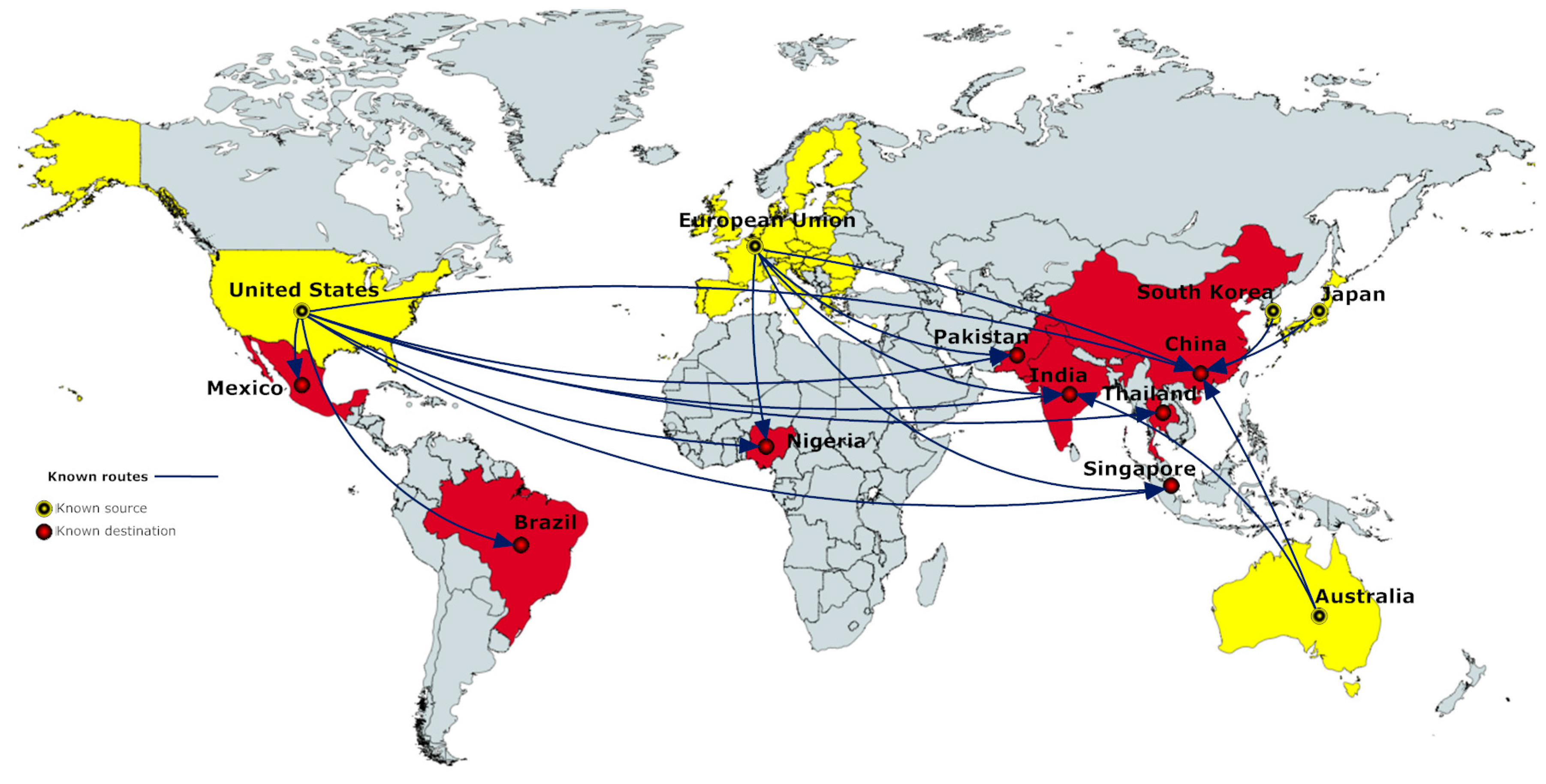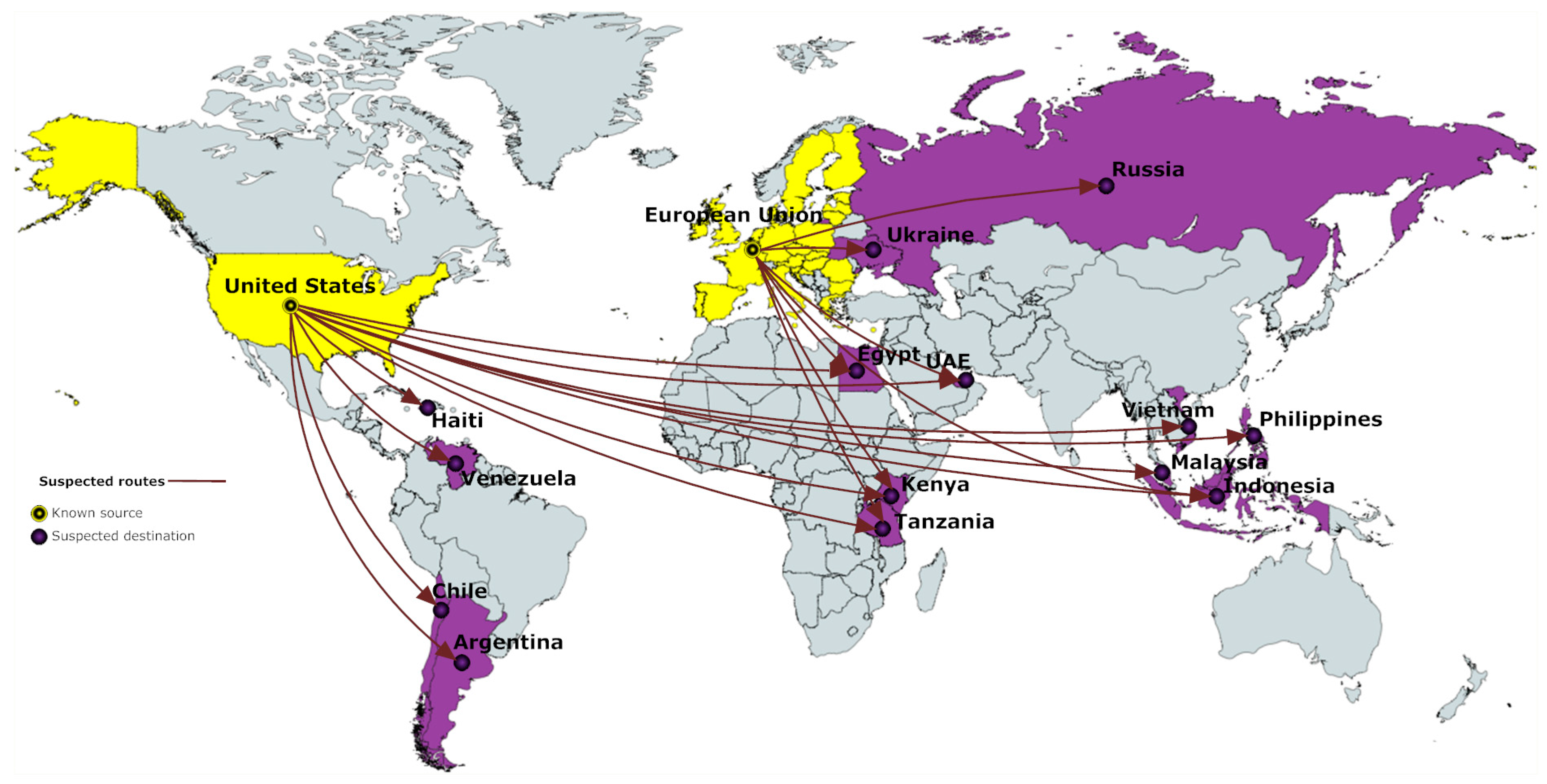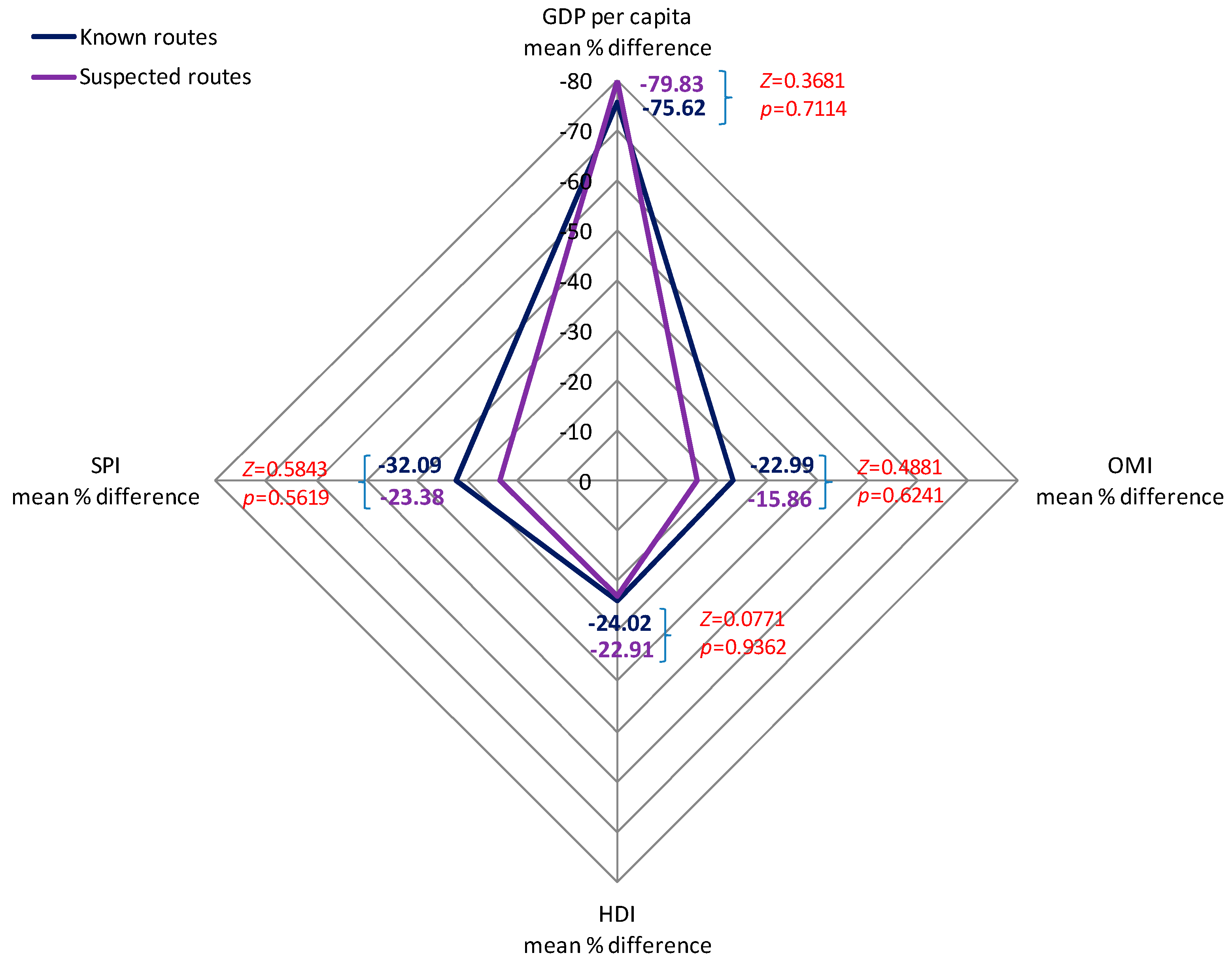This section consists of the discussion of our results on the effect of macroeconomic and social factors on illegal e-waste trade, followed by the limitations of this research.
4.1. Illegal E-Waste Trade
As indicated in the results section, there is a strong connection between high scorings and sender countries in both known and suspected routes. Our results suggest that, for all indicators taken into account in the present study, illegal e-waste trade occurs from developed to developing countries, with the exceptions of Singapore in the known routes in terms of GDP per capita, OMI, and HDI (no data for the SPI), and in the UAE in the suspected routes in terms of GDP per capita, and in Chile, Malaysia, and the UAE in OMI, but not in HDI and SPI. This suggests that even though economic development in the UAE, for example, is higher, social development is not—thus supporting the hypothesis that illegal e-waste trade is not only a matter of economic evaluation, but further parameters need to be taken into account, such as social development, lack of or loose relevant legislation, and law enforcement efficiency.
Table 5 consists of the average percentage differences between sender and receiver countries in GDP per capita, OMI, HDI, and SPI, for both known and suspected routes of illegal e-waste trade. Though all differences are negative—i.e., the sender country scores higher in all indices in both types of routes—GDP per capita shows a highly increased difference between the sender and receiver countries, highlighting that even though income is not the only reason for illegal e-waste trade, it is the most significant one, at least in terms of what is examined in the present study.
Figure 3 consists of the visualization of the average percentage differences between the sender and receiver countries in GDP per capita, OMI, HDI, and SPI for both known and suspected routes, in addition to the Z-tests of the percentages of each index in the two kinds of routes. We observe that the pattern between known and suspected routes is similar with small differentiations. In all four indices, the known and suspected routes’ differences are not statistically significant. So, basically, we observe that the known and suspected routes follow the same pattern in terms of differences in GDP per capita, OMI, HDI, and SPI.
Though illegal e-waste indeed flows from developed to developing countries, the issue of e-waste trafficking demands more complex approaches in order to be addressed, including international policy and regulations changes [
12]. Law enforcement agencies worldwide need to lay some common ground regulations in order to prevent other types of crimes connected with environmental crime, such as tax evasion, drug trafficking [
6], or money laundering [
23]. Developing countries will continue to be the receivers of e-waste because of the lack of a specific regulatory framework addressing e-waste management.
This type of environmental crime will not cease to exist until the limits between legal and illegal e-waste trade are clearly defined. In order for this issue to be addressed, a universal definition of what constitutes e-waste needs to exist, in order to simplify the identification of e-waste flows. A common method of misleading the local authorities is the use of free trade zones (as is Batam Island in Indonesia, where international and national regulation is not applicable [
16]), in an attempt to avoid any inspection or classification of e-waste by local authorities. In addition, the existence of a general code regarding e-waste would improve the detection of e-waste smuggling, as it would not permit the misclassification of products that are characterized as second-hand goods and are usually not taken into account in official statistics of e-waste trade. Furthermore, the existing codes are not harmonized, and they cannot be compared. Finally, the existing information on e-waste crime is based on controls made by the local authorities, which do not reflect the real extent of the crime [
5,
10]. These controls should be more intensive, as grey zones also exist [
16], where little or no control takes place. For example, smugglers prefer to ship through Hong Kong, Taipei, and the Philippines in order to avoid detection from the Chinese enforcement officers, and then ship the containers to smaller ports in the mainland of China in order to let them reach their final destination [
9].
4.2. Limitations
This study has some limitations. First, qualitative data are the basis of this research, and though the procedure of the quantification of the data and the obtained results are accurate, illegal e-waste trade cannot, by definition, provide quantitative data. Another data limitation is that the HDI does not take into account other aspects of human development, such as inequalities and poverty; thus, all social aspects are not fully integrated in the present research.
However, this study can provide ground for future research in illegal e-waste trade. Europe sends the majority of its e-waste to China [
24] and West Africa (especially in Nigeria and Ghana [
25]), while about 80% of the US’ e-waste is sent to developing countries, including China, Peru, Ghana, Nigeria, India, and Pakistan [
24]. Though small-scale exports to West Africa do exist, the majority of e-waste flows to South–East Asia [
9]. Despite the above, it is suggested that illegal e-waste trade occurs not only from developed to developing countries, but between developing countries as well, in addition to transboundary movements of e-waste between Asia and Africa [
12]. Furthermore, e-waste that is sent to China––the country that receives the highest portion of e-waste on a global level [
9]––is later exported to other countries in the region (e.g., Cambodia and Vietnam), while Singapore acts as a transit country, claiming e-waste as non-hazardous, thus not considering it to be under regulation [
9]. The same holds for the UAE, which is the only country scoring higher in the GDP per capita and OMI than the sender country in suspected routes. Based on the above, further research should be done when more data on the changing of the routes are available, as the subject of e-waste trafficking between developing countries is not within the scope of this paper, and thus is not included in our analysis.











